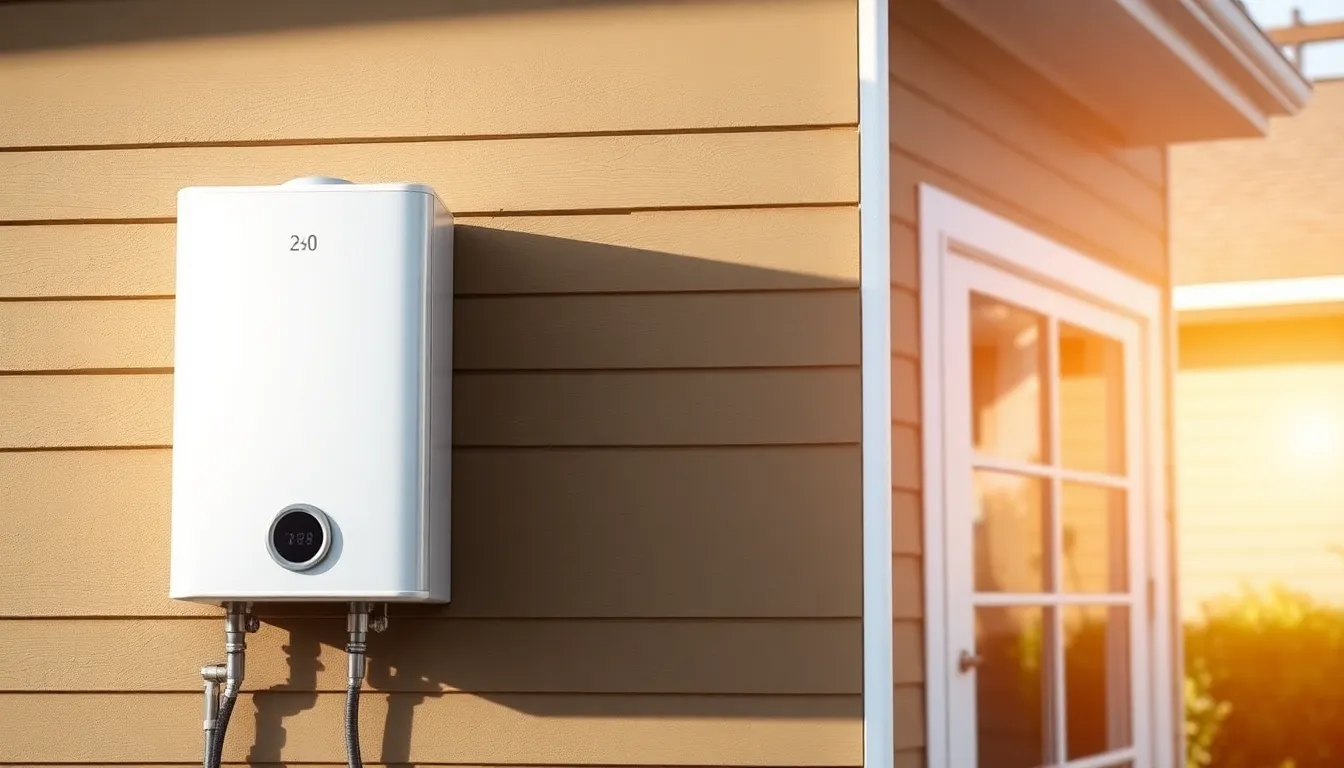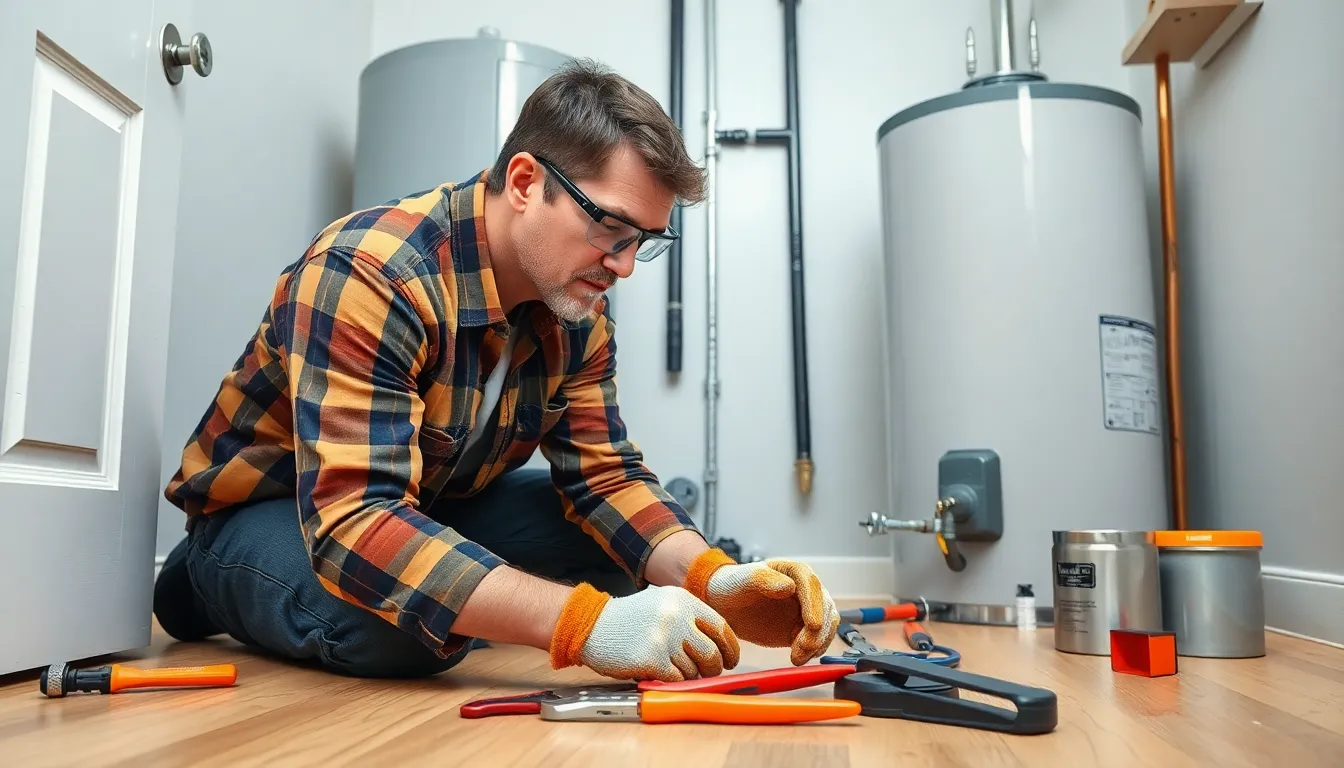Imagine stepping into a hot shower after a long day only to be greeted by a blast of icy water. Not the best way to unwind, right? A reliable water heater is essential for comfort and convenience in any home. Whether it’s for that soothing shower or for washing dishes without having to freeze your hands off, a proper water heater installation is key to keeping the hot water flowing.
Table of Contents
ToggleOverview of Water Heater Installation
Water heater installation plays a critical role in ensuring hot water availability in homes. Proper installation guarantees both efficiency and longevity of the unit. Important factors include selecting the right type of heater, whether tank or tankless. Each option has specific requirements regarding space and energy source.
Choosing the right location impacts performance and accessibility during maintenance. Adequate space around the unit allows for proper ventilation and easy servicing. Additionally, understanding local building codes and regulations is essential. Compliance ensures safety and can prevent costly future adjustments.
The installation process typically involves several steps. First, remove the old water heater, ensuring a safe disconnection from utilities. Next, connect the new unit, paying close attention to plumbing and electrical connections. Using the manufacturer’s guidelines during setup minimizes problems down the line.
Safety measures are crucial during installation. Installing a pressure relief valve prevents excess pressure build-up, safeguarding against potential leaks or ruptures. Also, securing the unit to prevent tipping over ensures safety, especially in earthquake-prone areas.
Regular maintenance follows installation. Flushing the tank annually eliminates sediment build-up, enhancing efficiency. Inspecting anode rods every three to five years prolongs the water heater’s life, preventing rust.
Consider these aspects when planning water heater installation. Awareness of detail not only promotes efficiency but also assures reliability in everyday use. Proper guidance leads to informed decisions, facilitating a smooth installation process.
Types of Water Heaters

Several types of water heaters meet varying household needs. Each type offers unique benefits and considerations.
Conventional Tank Water Heaters
Conventional tank water heaters store a set amount of hot water in a tank. These units range from 20 to 80 gallons, accommodating different household sizes. Operating continuously, they keep water heated and ready for use. Installation typically involves placing the unit in a basement, garage, or other accessible location. Maintaining these heaters includes flushing the tank annually and checking the pressure relief valve. Their longevity often extends beyond a decade, making them reliable choices for consistent hot water supply.
Tankless Water Heaters
Tankless water heaters provide hot water on demand. Unlike conventional units, they do not store water, which saves space and energy. These systems use high-powered burners to heat water instantly, allowing multiple outlets to operate simultaneously. Installation flexibility accommodates indoor or outdoor placements. Regular maintenance involves descaling to prevent mineral buildup. Lifespans often reach up to 20 years, highlighting their durability and efficiency.
Heat Pump Water Heaters
Heat pump water heaters leverage ambient air to heat water, offering significant energy savings. These units draw heat from the environment, making them exceptionally efficient. They generally require more installation space and optimal temperature conditions for maximum performance. Maintenance includes checking for airflow obstructions and cleaning filters. Typical energy efficiency ratings exceed 2.0, making them eco-friendly options. Their lifespan averages 10 to 15 years, with proper upkeep enhancing longevity and savings.
Preparing for Installation
Preparing for water heater installation requires careful planning and assessment. Understanding specific needs allows for optimal selection of the right heater.
Assessing Your Home’s Needs
Assess the household’s hot water requirements. Consider factors like the number of family members and peak usage times. Determine whether a tank or tankless water heater fits best based on consumption patterns. Analyze the space available for installation, as size impacts efficiency. Review the energy source, whether electric, gas, or solar, to optimize cost-effectiveness. These evaluations lead to informed decisions that enhance comfort and reliability.
Choosing the Right Location
Positioning the water heater significantly affects performance and maintenance. Choose a location close to where hot water is most frequently used, minimizing heat loss. Ensure adequate ventilation, especially for gas-powered heaters, to promote safety. Maintain a level foundation to support the unit. Consider accessibility for repairs and regular maintenance, as this reduces potential issues in the future. A well-chosen spot enhances efficiency and streamlines operations, ensuring a steady supply of hot water.
Step-by-Step Installation Process
Installing a water heater involves a series of organized steps that ensure safety and efficiency. Proper preparation leads to a smooth process, maximizing the heater’s performance.
Gathering Necessary Tools and Materials
Gathering the right tools and materials simplifies the installation process. Essential tools include a pipe wrench, pliers, screwdrivers, and a drill. Safety gear, like gloves and goggles, protects against any hazards. Materials such as water supply lines, connectors, and tape for sealing leaks are crucial. Additionally, it’s wise to have a new pressure relief valve on hand, as this is vital for safety. Confirming that all necessary items are ready before starting minimizes delays.
Installation of the Water Heater Unit
Installation of the water heater unit begins with safely removing the old unit. Careful disconnection ensures no damage to existing plumbing. Placing the new unit in the predetermined location requires attention, as this impacts efficiency. Leveling the heater before securing it stabilizes the unit for safe operation. Following manufacturer instructions ensures accurate installation, which helps prevent future issues. Finally, attaching the temperature and pressure relief valve is essential for safety.
Connecting Plumbing and Electrical Supply
Connecting plumbing and electrical supply forms a critical step in the installation process. Ensure the water supply line connects securely to the heater input. Using Teflon tape on threads prevents leaks at connection points. When dealing with electrical connections, shut off power to the circuit beforehand. Add the electrical connections according to manufacturer guidelines to maintain safety standards. Testing connections is essential to ensure everything works properly before the final inspection.
Common Challenges and Solutions
Water heater installation often faces several challenges. A common issue involves inadequate space for the new unit. Assessing the designated area before purchase helps avoid complications. Incorrect sizing poses another challenge. Determining the household’s hot water demand ensures the right capacity is chosen.
Leaking connections can occur during installation. Utilizing Teflon tape and tightening fittings properly minimizes this risk. Poor alignment of plumbing connections may lead to leaks as well. Ensuring all connections align correctly before sealing reduces potential water damage.
Electrical issues frequently arise. Relying on a qualified electrician guarantees safe electrical setup. Lack of proper ventilation creates problems, especially for gas water heaters. Installing venting solutions according to local codes prevents hazardous situations.
Unexpected noise from the unit after installation can also be problematic. Investigating potential sources, like sediment buildup, aids in finding solutions. Temperature fluctuations might affect comfort levels as well. Adjusting the thermostat or recalibrating might solve this problem.
Finally, compliance with local building codes remains essential. Checking regulations beforehand avoids potential fines or required modifications. Understanding these common challenges encourages efficient planning and execution of water heater installation, ensuring a more successful process.
A properly installed water heater is vital for ensuring a steady supply of hot water in any home. Choosing the right type of heater and understanding the installation process can significantly impact overall performance and efficiency. By adhering to safety standards and local building codes, homeowners can avoid potential issues that may arise from improper installation. Regular maintenance further enhances the heater’s lifespan and efficiency, providing peace of mind for daily use. Investing time and effort into the installation and upkeep of a water heater pays off in comfort and convenience for years to come.



